New Comic Book Day: Just Nominate Everyone
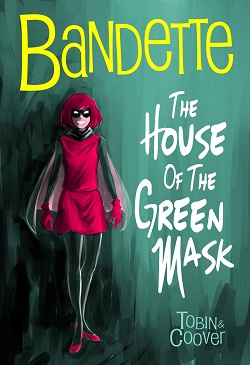 |
| Monkeybrain Comics |
This year’s Eisner nominees were announced a couple of weeks back, and the more I think about it, the biggest travesty in the entire process is that they just don’t have enough slots for nominees. Take a look at that list and tell me what you disagree with. Okay, I mean, maybe don’t do that, because this is the Internet and if we’re good at anything, it’s getting all pissed off about people who don’t share our opinions, but at the same time, opinion-based disagreements aside, there’s nobody who’s nominated for an Eisner who really shouldn’t be. I’ve gone through every category, and I can find two or three books or creators who I think should be on there, but not at the expense of anyone who made it. That’s why I think they should go full Oscars and expand each category to 10 nominees, so at least we can actually capture the full breadth of the awesomeness going on in the coloring game right now.
This week in comics, worlds break. A lot of worlds. A lot a lot. But first, an Eisner nominee!
Bandette #10 (Monkeybrain Comics)
Statistically speaking, Bandette has to be one of the most successful comics ever. There have been 10 issues of the series, and it has received 7 Eisner nominations. That’s absurd on its face, but once you actually read the comic, it makes perfect sense. If you get more than 2 pages into an issue and you don’t subconsciously have a smile on your face, then…well, buddy, I guess we have different tastes in comics. FLAMEWAR!
Anyway, this issue is the start of a new arc for the remarkably pleasant French thief, and it has Bandette planning a heist at the once-in-a-lifetime showing of a biographical film about her idol and the most interesting woman in the world. So often, painted comic art isn’t fine enough to capture the full subtlety of facial expressions, but not here. Coover’s facial expressions are so vivid and her action flows so well that it all contributes to that general happiness that you feel when you read this comic. And Paul Tobin’s script is light, quick, clever and very sharp. I just really love reading this comic.
You can pick up Bandette #10 online via Comixology.
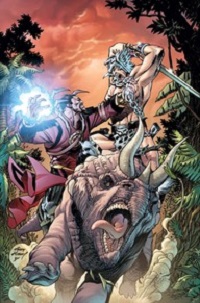 |
| DC Comics |
Convergence #5 (DC Comics)
We’re crossing the midline on Convergence this week, and as much as I wanted to talk about Convergence: The Question (reminder: it’s fantastic), I think it’s worth taking a look at the main series, because it’s rounding into form pretty nicely.
Every side book except for Booster Gold has its formula: heroes are trapped under the dome, anyone with powers doesn’t have them, and then the dome comes down and it’s fight time. The main series is only touching on those fights, and instead following the characters from Earth-2: World’s End as they go after Telos, the evil planet hosting all these domed cities, deciding which timeline gets to continue to exist once DC’s Burbank offices are up and running. The point-of-view character is Earth-2 Dick Grayson, who from what I can gather is relatively new to the hero game and works well in the role.
I’ve said before that Convergence as an event was mostly fan-wanky continuity porn, and I stand by that assessment at that time. But as the series has gone along, Jeff King has done a good job of making it a fun event all of its own, and even though it’s making me hemorrhage money, I’m really digging it.
You can pick up Convergence #5 at your friendly local comic shop or online via Comixology.
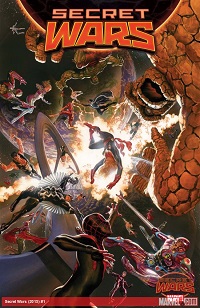 |
| Marvel.com |
Secret Wars #1 (Marvel Comics)
It’s facile and reductive to continue drawing parallels between what DC and Marvel are doing, but at the same time, they’re running two huge events that are basically the exact same premise at almost the same time, so go to hell I’m gonna do that anyway.
If Convergence is a fluffy snack platter, giving you a tiny taste of a bunch of different classic hits, then Secret Wars is its heavy, SERIOUS BUSINESS polar opposite, a seven layer dip of universe shattering consequences and I’m amazed that I managed to hang onto that metaphor for this long. I broke my Marvel Unlimited slow-exile on Hickman’s Avengers last weekend in a fit of excitement for this series, and when I finished binging on the 12 issues that filled in the gap, I needed a break, because this shit is bleak. It’s STUNNING, but it’s dark as hell. I’m going to do my best not to spoil anything, but when a story’s acknowledged endgame is to “figure out how not to lose,” it’s not going to be a sunny punch-up where everyone comes out happy.
That said, Hickman’s Avengers is only act 2 of the story he’s trying to tell. What amazed me the most about these two series (adjectiveless and New) is how much of a continuation of his Fantastic Four it was. I see Secret Wars as the conclusion of a much longer, REALLY amazing story about Reed, Doom and Valeria that, I think, he got the idea for while writing Ultimate Super Best Ultimates Comics about the Ultimates in the Ultimate Universe, but really kicked off with “Solve Everything.” If you’ve been following since then, I have a feeling the payoff here is going to be amazing.
You can pick up Secret Wars #1 at your friendly local comic shop or online via Comixology.
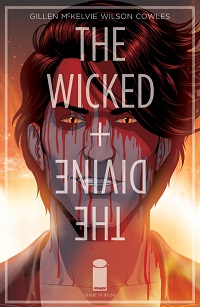 |
| Image Comics |
The Wicked + The Divine #10 (Image Comics)
On a strictly superficial level, I shouldn’t really like this comic. It’s urban fantasy starring a teenager fangirling about goth gods come to Earth in human form, wrapped up in modern Britpop culture. Whereas I’m the guy excited for what I assume will be the all nu-metal soundtrack to the follow up to X-Men: Apocalypse since it’ll be the one that takes place in the ’90s (that pretty much HAS to be X-Force, doesn’t it? I mean, come on. Warpath’s lips may have said “Porno for Pyros,” but his surliness was saying “I’m thinking about adding a 7th string to my guitar”). So the fact that The Wicked + The Divine works so well is, I think, a demonstration of just how gifted Gillen, McKelvie and Wilson are.
Every 90 years, a batch of gods merge with a group of humans. They then change the world, and die after two years of being on Earth. It’s a simple hook that only gets in deeper when Gillen layers in a murder mystery as the main plot propulsion device, and 10 issues in, we’re just starting to get an idea for where the story is going, but the worldbuilding is so deep and so interesting that its relaxed pace is almost necessary. McKelvie is one of the best artists in the game right now, and he’s able to pull from a variety of influences to make the gods’ designs visually stimulating but relatable at the same time. And, since we’re talking about the Eisners this week, Matt Wilson’s bright pop colors are absolutely deserving of being on the Best Colorist list this year.
The Wicked + The Divine isn’t going to be for everyone, but I think it’s worth a shot. It’s a really good, really well crafted comic book.
You can pick up The Wicked + The Divine #10 at your friendly local comic shop or online via Comixology.
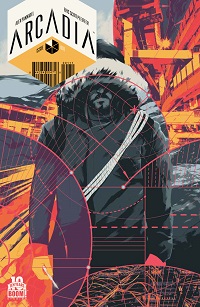 |
| Boom! Studios |
Arcadia #1 (BOOM! Studios)
If you take The Matrix, add in disease horror and strip out everything that had anything to do with The Architect, you get Boom’s big new book this week, Arcadia.
It’s big on deep world building, and it’s an interesting premise. A disease has killed 99% of the people on the planet, and many of them have transferred their consciousnesses into server farms. They live on in a simulation, and are mostly immortal (the “mostly” is the cliffhanger the issue ends on). The 1% remaining alive are still combatting the disease, and losing. The “meat world” scenes take place at a server farm in Alaska, while the Arcadia scenes bounce between cyber-LA and a cyber United Nations. Eric Scott Pfeiffer, the artist on the book, does a good job designing the two worlds: Arcadia is a neon sensory overload nightmare, and Pfeiffer shows us right away that there are no physics (nor any design sense less offensive than “garish”) as we know it. He adds in some nice touches about the meat world, too – I really appreciated that he populated the server farm with some plants, using the building as an Alaskan greenhouse.
Alex Paknadel takes the lack of physics and shows the reader the psychological effects of being entirely digital and unable to die. The callousness of the people in Arcadia is supposed to be off-putting, and it very much was. He also layers in some of the political consequences of the disease, a layer I really appreciated. It’s so easy to get that stuff wrong, but Paknadel seems to have really thought about it. My one beef with the book is the lack of sound effects – a wolf gets shot early on in the book, but the page is missing a bang HA ha.
You can pick up Arcadia #1 at your friendly local comic shop or online via Comixology.
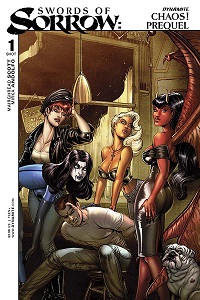 |
| Dynamite Comics |
Swords of Sorrow: Chaos Special (Dynamite Entertainment)
Swords of Sorrow is a big crossover where all of Dynamite’s lady characters – Dejah Thoris, Red Sonja, Vampirella, etc – are pointed towards the same enemy, Seven Soldiers-style. Meanwhile, the enemy has gathered all of the women of Chaos Comics to guard him while he conjures up…something…and if that’s not ripe for a double cross, then I’m a dribbling idiot.
On a more meta level, Swords of Sorrow is a big crossover where Dynamite handed Gail Simone a bunch of characters and the number of books they wanted to see tie in to the crossover, and they said “go nuts.” I’m very cool with that. I generally enjoy Simone’s writing because it seems like we have similar tastes, so I’m inclined to trust her picks for her companions on the miniseries. This week’s book is a Chaos feature written by Mairghread Scott, who has been kicking ass on IDW’s Transformers books lately. She spends a little time with the villains of the story, gives us a nice introduction to how they feel about each other, and adds a little depth to the main mini’s conflict. It’s a solid cheesecakey breeze of a read, and if you dig the main crossover, you should enjoy this a lot.
You can pick up Swords of Sorrow: Chaos Special at your friendly local comic shop or online via Comixology.
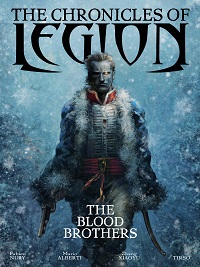 |
| Titan Comics |
The Chronicles of Legion volume 3: Blood Brothers (Titan Comics)
The third volume of Fabien Nury, Tirso, Zhang Xiaoyu and Mario Aliberti’s story about a time-spanning battle between Dracula and his brother comes out this week. The story is an extension of the Dracula myth – Vlad Tepes and his brother Radu are immortals constantly battling each other for…whatevers. It adds an interesting layer of backstory/myth to their origins at the end of the volume, so if you’re a Dracula fan or if you’ve got a thing for 14th century Romanian history, this book is right up your alley.
Each artist draws a different time period – Xiaoyu gets 1812 Russia, while Aliberti draws the part of the story in mid-16th Century South America and Tirso covers the section in 1885 London. Xiaoyu’s art is heavily inked and dark, almost European in style, but very clean and easy to follow, and Tirso’s is bright and almost straight pencils to page crisp, a good contrast to Xiaoyu’s. It’s a little counterintuitive, but Aliberti’s art, despite being for chronologically the oldest part of the story, is the cleanest and most modern of the bunch. It’s also hella gory – I was surprised when I saw a guy’s face get separated from his head, and now I REALLY need to get Mortal Kombat.
You can pick up The Chronicles of Legion Volume 3: Blood Brothers at your friendly local comic shop or online via Comixology.
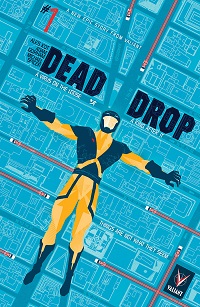 |
| Valiant Comics |
Dead Drop #1 (Valiant Comics)
Dead Drop is billed as an espionage book starring X-O Manowar, and Valiant made a great choice putting it in the hands of Ales Kot and Adam Gorham. Gorham’s art is pretty fantastic. There’s a chase sequence that starts on about page 7 that the first word that came to mind while reading it was “outstanding.” There were cut ins and neat close ups, and it was really dynamically laid out and energetic.
Kot’s best work comes when he’s tiptoeing the line of “weird for its own sake.” Zero is a bizarre comic that, even when it gets complicated or bizarre, never gets worse than tough to follow. On the other hand, I stopped reading The Surface because it felt way too enamored with itself – too happy about the crazy ideas, too amused at how referential it was. Dead Drop feels like it’s hitting a nice middle ground. To be honest, Kot often does well constrained by work for hire. Working on existing characters puts a box around him and usually precludes him from abusing his own worst tendencies, or as it’s more commonly known, crawling up his own ass.
You can pick up Dead Drop #1 at your friendly local comic shop or online via Comixology.
No lookback this week because Bandette was so much fun. My pull list was pretty heavy. What are you grabbing this week?

